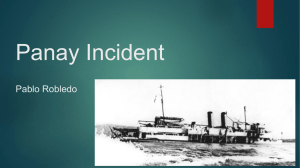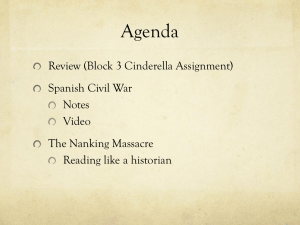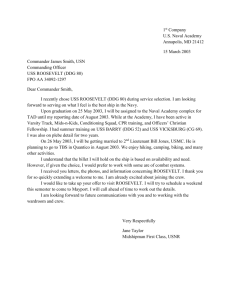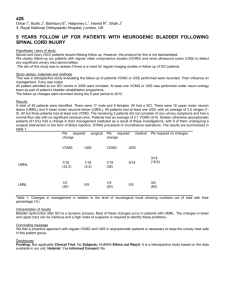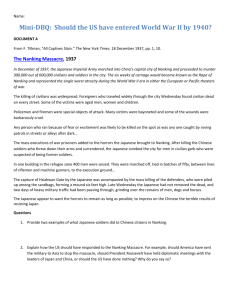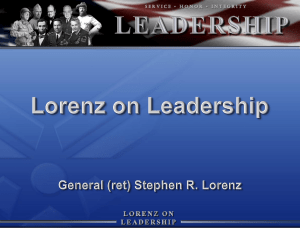U.S Gunboat Panay
advertisement
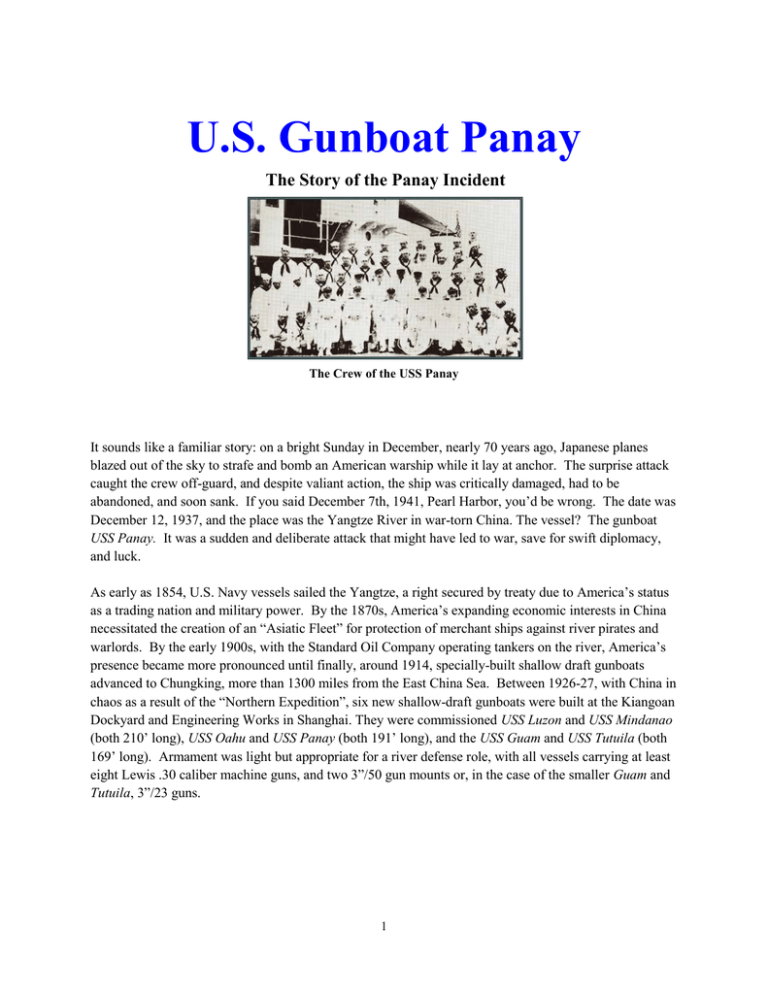
U.S. Gunboat Panay The Story of the Panay Incident The Crew of the USS Panay It sounds like a familiar story: on a bright Sunday in December, nearly 70 years ago, Japanese planes blazed out of the sky to strafe and bomb an American warship while it lay at anchor. The surprise attack caught the crew off-guard, and despite valiant action, the ship was critically damaged, had to be abandoned, and soon sank. If you said December 7th, 1941, Pearl Harbor, you’d be wrong. The date was December 12, 1937, and the place was the Yangtze River in war-torn China. The vessel? The gunboat USS Panay. It was a sudden and deliberate attack that might have led to war, save for swift diplomacy, and luck. As early as 1854, U.S. Navy vessels sailed the Yangtze, a right secured by treaty due to America’s status as a trading nation and military power. By the 1870s, America’s expanding economic interests in China necessitated the creation of an “Asiatic Fleet” for protection of merchant ships against river pirates and warlords. By the early 1900s, with the Standard Oil Company operating tankers on the river, America’s presence became more pronounced until finally, around 1914, specially-built shallow draft gunboats advanced to Chungking, more than 1300 miles from the East China Sea. Between 1926-27, with China in chaos as a result of the “Northern Expedition”, six new shallow-draft gunboats were built at the Kiangoan Dockyard and Engineering Works in Shanghai. They were commissioned USS Luzon and USS Mindanao (both 210’ long), USS Oahu and USS Panay (both 191’ long), and the USS Guam and USS Tutuila (both 169’ long). Armament was light but appropriate for a river defense role, with all vessels carrying at least eight Lewis .30 caliber machine guns, and two 3”/50 gun mounts or, in the case of the smaller Guam and Tutuila, 3”/23 guns. 1 The crews of these ships were small. Panay for example carried four officers and forty-nine enlisted men, along with a Chinese crew of porters. The vessel only drew about five feet of water, and resembled more of a Mississippi riverboat than a destroyer. Yet it had a definite role to play, one summed up on a bronze plaque located in the wardroom: “Mission: For the protection of American life and property in the Yangtze River Valley and its tributaries, and the furtherance of American goodwill in China.” For Newspaper Headline the day after the bombing of the USS Panay the men of the U.S. Navy, an assignment to the Yangtze Patrol was a plum. A seamen’s wages went a long way in China, and there was no shortage of good food and female companionship. The pirate-fighting “river rats” had a certain swagger to them, one underscored by a rough and ready attitude and plenty of facial hair. Unlike their ocean-going counterparts, the “rats” were allowed to wear beards. The unstable political and military situation in Asia in the 1930s put the Yangtze Patrol on its guard. With Nationalist and Communist armies struggling for control along the river, and Japan signaling expansionist goals, it appeared inevitable that the U.S. Navy would be caught in the fray. The outbreak of the Second Sino-Japanese War in July of 1937 raised the stakes considerably. Japan’s assault at the Marco Polo Bridge was widely viewed in the United States as an imperialistic act of aggression. While America outwardly maintained status as a neutral nation, many believed steps should be taken to curtail Japan’s pugnaciousness. Diplomats threatened sanctions, but the U.S. could do little to change the situation on the ground. 2 November of 1937 found the Japanese Army racing towards Nanking, its troops operating on the southern bank of the Yangtze and in the river delta. As Iris Chang recounts in The Rape of Nanking, the Japanese army left a swath of destruction in its path, murdering helpless civilians, committing countless rapes, and conducting wanton atrocities. The fall of the city would prove to be one of the bloodiest episodes in WWII, with more than 300,000 Chinese civilians and soldiers killed in a mere six weeks. The death toll, Chang notes, “exceed(ed) that of the atomic blasts of Hiroshima and Nagasaki combined”. Map of Nanking and surrounding region The offensive moved with a speed that caught everyone, even the Japanese, off guard. As Chiang Kai-shek’s army collapsed, Ambassador Joseph Grew and his staff abandoned Nanking and retreated to Chungking, some 1200 miles distant, aboard the USS Luzon. A skeleton crew of four men, including Second Secretary George Atcheson, Jr. and Vice Consul J. Hall Paxton, stayed behind to monitor events and attempt to safeguard those European and American civilians who remained. The existence of an “International Safety Zone” for the nonChinese did little to lessen the danger to the staffers or other Westerners however, as Japanese artillery and aircraft brought indiscriminate destruction to the city. Panay however offered an escape route, and would stay in the vicinity of Nanking as long as possible so that the embassy staff and anyone else who chose to leave, could do so. USS Panay Commander James J. Hughes Even though the U.S. Navy operated as a neutral party on the Yangtze, entering the war zone involved considerable risk. To minimize the chance that Panay might become a target, Lt. Commander James J. Hughes had his men lash large American flags horizontally across the upper deck awnings, and a gigantic 6’ x 11’ Stars and Stripes displayed from the gaff before the ship sailed from Shanghai. At night while anchored off Nanking, the ship was to be illuminated and the flag spotlighted. The ship’s twin motor sampans, dispatched to the docks to pick up passengers, would also carry large flags. 3 Hughes was a taskmaster. A native New Yorker, he attended Annapolis in 1915 and earned a reputation for his intelligence and stern judgment. According to Darby Perry, author of the definitive work The Panay Incident, Hughes “pushed himself through a number of …courses that a professional naval officer would need for advancement and a Yangtze Patrol officer might need for survival when operating independently and with almost unlimited authority deep inside China.” At his side was another Naval Academy graduate, Lt. Arthur Anders, from Weimar, Texas — and nicknamed “Tex” as a result. A strict man who made sure his captain’s orders were followed to the last detail, Anders nevertheless had an informal side. Perry notes that that at Annapolis Anders was “always ready to plop down on a bunk for a bull session” and well known for his ability to do well in class despite rarely seeming to study. On December 5th, an evacuation order was sent by George Atcheson, Jr., stating that “The Embassy considers it inadvisable that Americans remain longer in Nanking. All Americans are urged to foregather at the Embassy west compound tomorrow morning, December 6th, at 9:30 a.m., to proceed in a group to the Bund and embark on the USS Panay.” The refugees were advised that only one suitcase per person would be allowed. By the 9th, a surprisingly small group of fifteen dependents had assembled aboard Panay: four embassy staffers, four U.S. nationals, and four US Embassy in Nanking foreign nationals. Most of them were journalists, including one of Universal News’ premiere cameramen, Norman Alley. Also on board was Eric Mayell of Fox Movietone, James Marshall of Colliers, photographer Norman Soong of the New York Times, United Press’ Weldon James, G.M. McDonald of the London Times, and two Italian writers, Sandro Sandri and Luigi Barzini, Jr. Most war correspondents are by nature adrenalin junkies. No exception to the rule, Norman Alley felt slightly heartsick at boarding the Panay to be evacuated. He might very well be leaving a headline story behind. A compatriot, Arthur Menken of Paramount News, decided to stay in Nanking and view the maelstrom. That was too much for Alley, although he was typically fearless to the point of recklessness — during WWI he’d been gassed while reporting from the front lines. On December 4th, he’d snuck over to the railway yards at Pukow, across the river from Nanking. War correspondent Norman Alley There he witnessed a grim spectacle, as Japanese aircraft strafed helpless refugees. When a frightened man mistook Alley’s turreted 16mm camera for a machinegun, the newsman nearly became a victim himself. Such things did not ruffle a man like Alley; he simply made certain in the future to hold the camera at his side when not taking pictures. “My credo is this,” he told George Atcheson, “Go to hell if you must — but bring back pictures of it.” On the afternoon of the 9th, Japanese artillery rounds began falling into Nanking’s harbor about 200 feet 4 Hughes and Secretary Atcheson determined that it from the Panay. After a brief conference, Commander was time to depart the Bund. “That night all of us stood and watched the burning and sacking of Nanking,” Alley later wrote in his memoir I Witness, “until we had rounded the bend and saw nothing but a bright red sky silhouetted with clouds of smoke.” Once the warship arrived at its new position, adjacent 5
